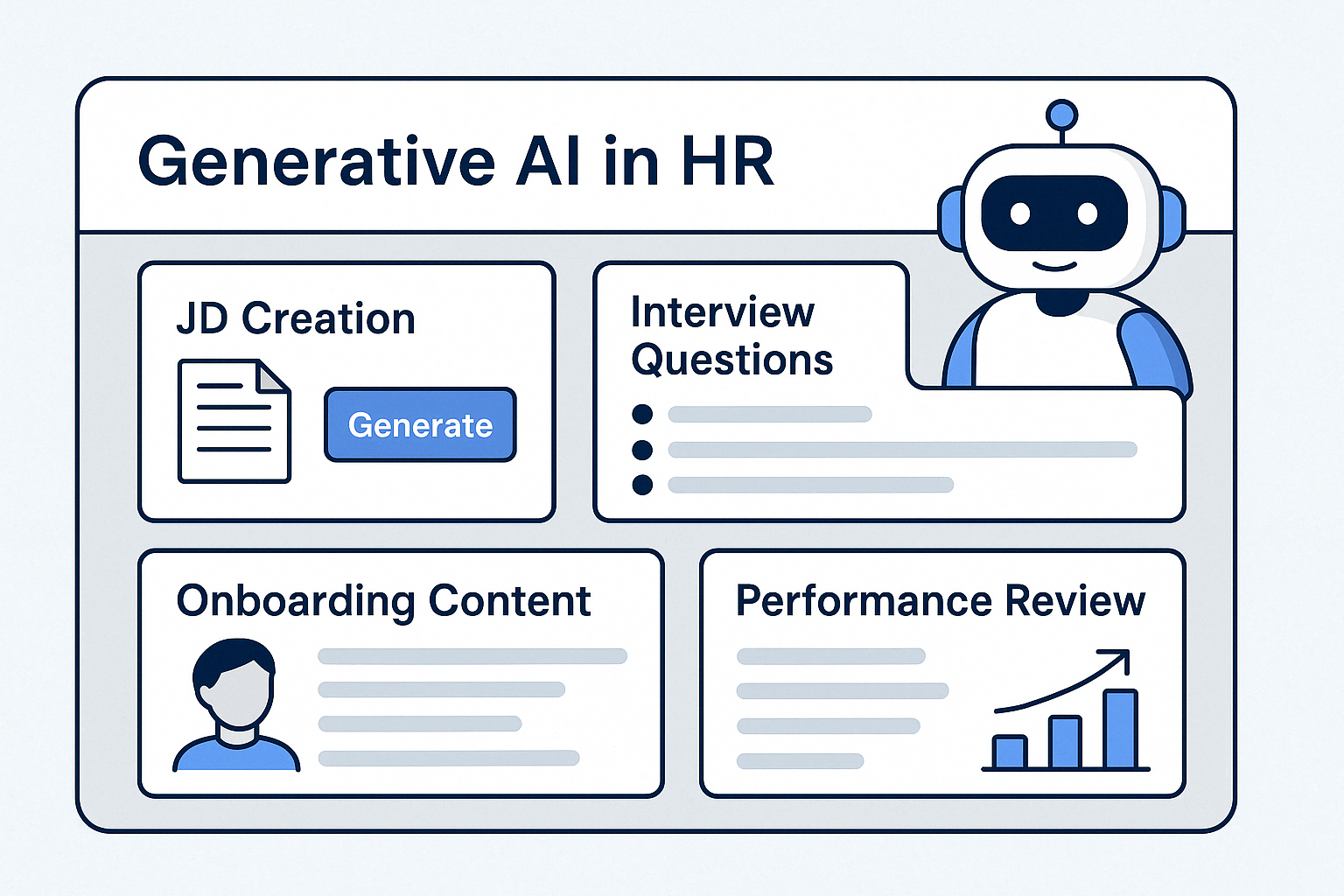Generative AI in HR: Transforming Human Resources Through Intelligent Creation
What Is Generative AI in HR?
Generative AI in HR refers to the use of AI models—especially large language models (LLMs)—that can generate human-like content and insights to support and automate human resource functions. Unlike traditional rule-based systems, generative AI can understand context, learn from data, and produce personalized outputs, making it a game-changer for talent acquisition, employee experience, and people analytics.
From drafting job descriptions to crafting personalized onboarding journeys and summarizing feedback, Generative AI turns HR into a proactive, data-enriched, and scalable function.
🔗 Related term: AI in Performance Management
🔗 Related term: AI Recruitment
🔗 Related term: Welcome Portal
Key Applications of Generative AI in HR
Use Case | Description |
|---|---|
✍️ JD & Job Ad Creation | Auto-generate role-specific job descriptions and outreach copy tailored to tone, skills, and diversity standards. |
🧠 Interview Questions & Evaluation Prompts | Suggest structured interview questions aligned to the job profile and performance metrics. |
🎯 Personalized Onboarding Content | Generate learning guides, welcome messages, or custom FAQs for each new hire. |
📈 Performance Review Summaries | Convert peer feedback, manager comments, and data into coherent, bias-aware performance narratives. |
💬 Employee Chatbots | Handle HR queries on leave, policies, or career planning with natural language interaction. |
📊 Talent Analytics Reports | Summarize trends in retention, DEI, or engagement using internal data and AI-generated insights. |
Benefits of Generative AI in HR
✅ Time Savings
HR teams reduce repetitive tasks like drafting emails, JDs, reports, or feedback documentation.
✅ Consistency & Compliance
AI ensures uniform tone and adherence to legal or brand requirements across communications.
✅ Personalization at Scale
Tailor onboarding paths, learning content, and surveys automatically—without manual labor.
✅ Better Experience
Candidates and employees interact with responsive, 24/7 AI agents that deliver answers instantly.
✅ Data-Driven Intelligence
Summarize unstructured text (like feedback, survey answers) into trends for leadership action.

Real Examples of Generative AI in Action
AI-powered JD builders from tools like Moka use GPT-style models to generate optimized job descriptions aligned with skills taxonomy and tone of voice.
Interview Assistant bots suggest role-specific questions, assign scores, and summarize responses for HR review.
Performance AI tools automatically draft evaluation summaries from 360° input and performance data, saving hours for managers.
Onboarding copilots guide new hires through tasks, policies, and documentation with interactive AI agents.
Best Practices for Implementing Generative AI in HR
Start with low-risk, high-volume tasks (e.g. job description generation, FAQ automation).
Ensure human-in-the-loop validation for decision-impacting outputs like feedback summaries.
Train on relevant, diverse datasets to improve accuracy and fairness.
Continuously audit for bias, especially in candidate-facing or performance applications.
Be transparent with users about AI-generated content and give override or feedback options.
Common Challenges and How to Overcome Them
Challenge | Solution |
|---|---|
Bias in generated content | Use DEI checkers and diverse training data; validate output with humans |
Hallucinated or inaccurate info | Fine-tune models on internal HR data; implement prompt control |
Compliance concerns | Include legal reviews, maintain audit logs of AI-generated materials |
Resistance from HR teams | Provide education, involve users in prompt building, highlight time saved |
FAQ: Generative AI in HR
Q1: How is generative AI different from traditional HR automation?
Generative AI creates original content (text, summaries, prompts), while traditional tools automate structured workflows (forms, approvals).
Q2: Is it safe to use Generative AI in sensitive HR contexts?
Yes—with safeguards like data privacy compliance, human review layers, and ethical AI standards.
Q3: Can it replace HR professionals?
No. It augments human capability by handling repetitive or creative support tasks, freeing up time for strategic and empathetic work.
Q4: What’s the future of generative AI in HR?
Expect deeper integration into ATS, HRIS, LMS, and EXP systems—providing smart copilots across the employee lifecycle.
Conclusion
Generative AI in HR marks a shift from manual, reactive processes to intelligent, proactive experiences. When thoughtfully integrated, it doesn’t just reduce admin burden—it elevates the HR function into a strategic force that adapts quickly, communicates clearly, and scales effectively. In the age of AI, human resources become more human than ever.
HR Glossary: Master the Language of Modern HR
From recruiting candidates to onboarding new team members, MokaHR gives your company everything you need to be great at hiring.
Subscribe for more information

